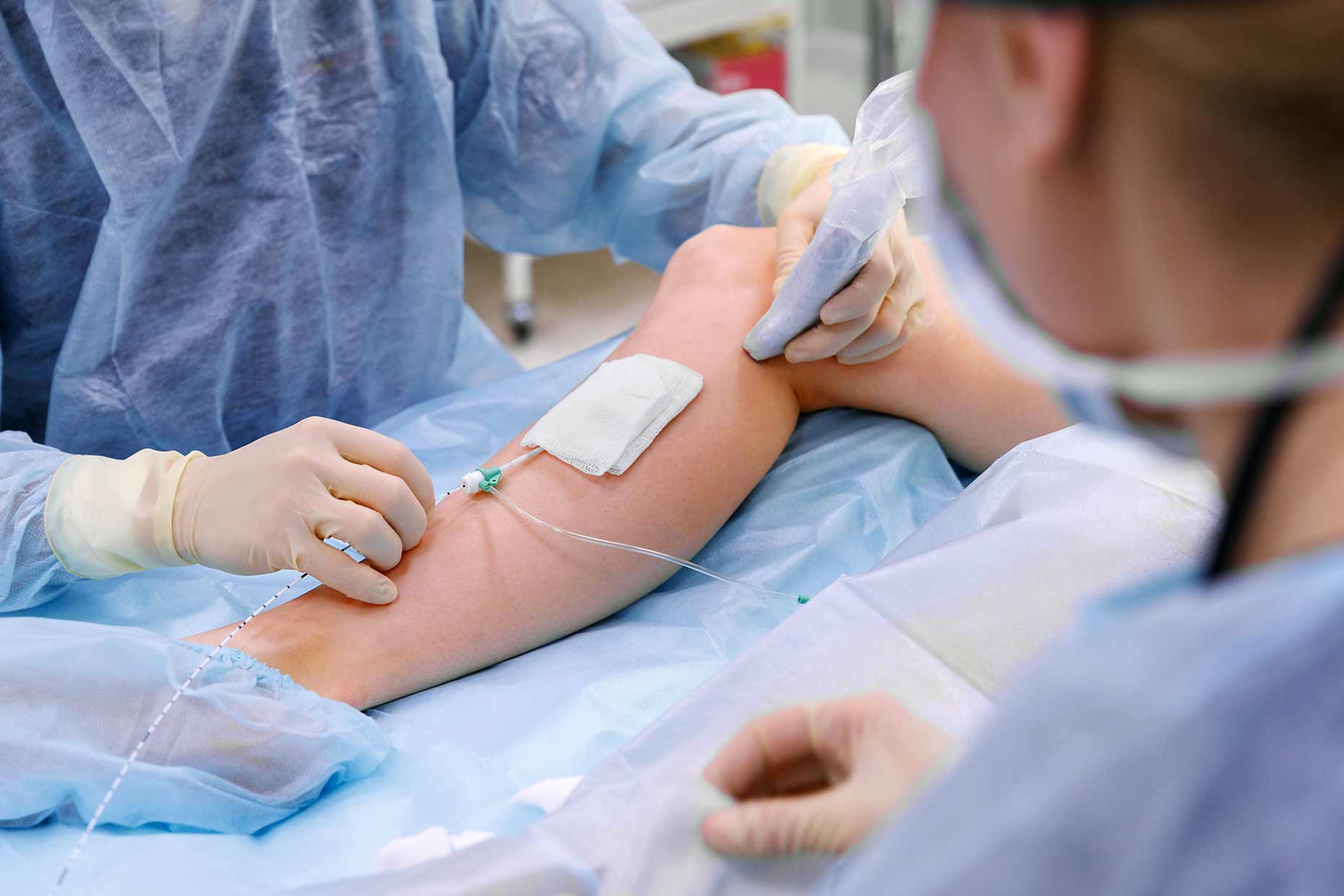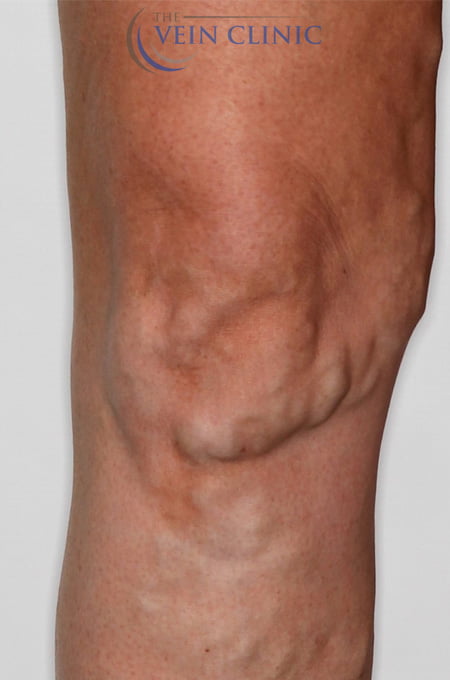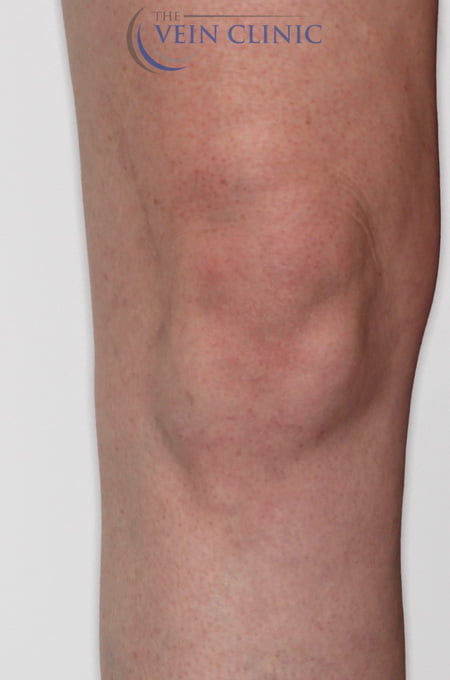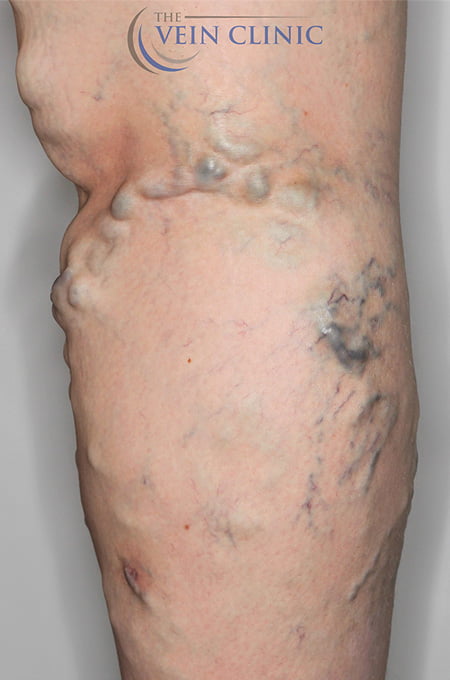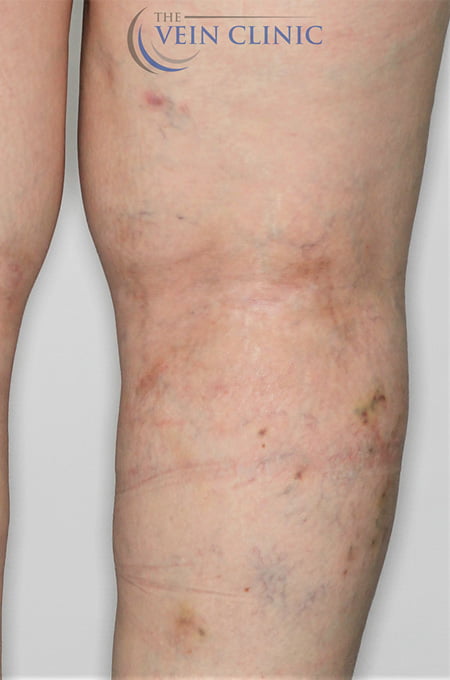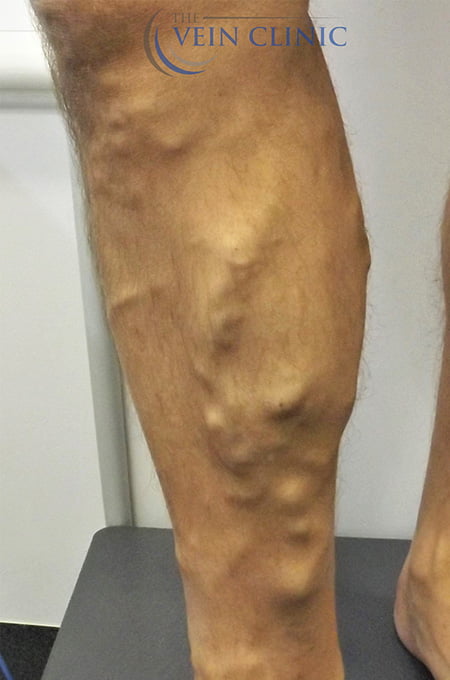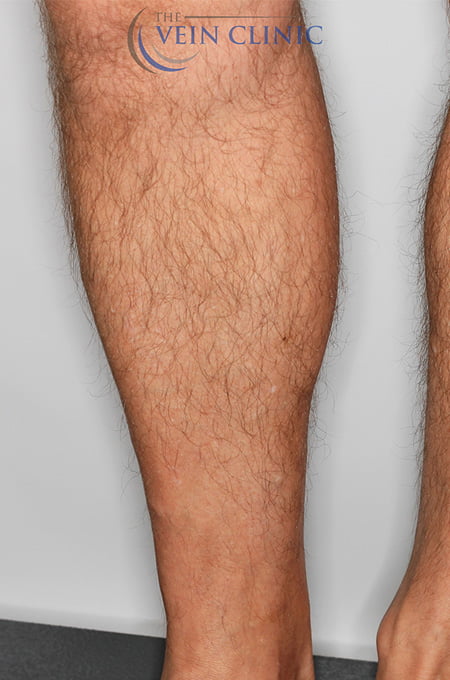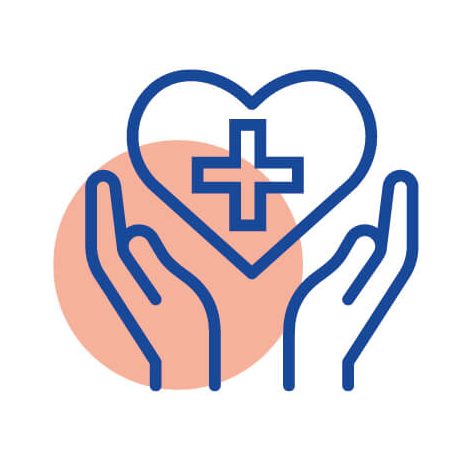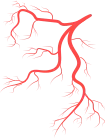Perth's Leading Specialist in the Treatment of Varicose Veins
Dr Luke Matar | MBBS, FRANZCR, FACP
What is Endovenous Laser Treatment (EVLA)?
Laser treatment for varicose veins known as Endovenous laser ablation (EVLA) is currently the most effective alternative to surgical vein stripping of large malfunctioning veins. Endovenous laser ablation is the preferred treatment for varicose veins larger than 6mm in diameter.
It is a very well-tolerated procedure; our initial success rates are >99% and far superior to those achieved surgically. Recurrence rates at 5 years post-treatment are only 5% compared to 50% with surgical removal, making laser treatment for varicose veins a significantly advanced treatment choice.
As there is no physical removal of the varicose vein from the body, there is much less associated trauma and discomfort, and recovery times are far shorter than with other techniques.
EVLA is performed by Dr Matar in our state-of-the-art Perth treatment centre, as a walk-in walk-out procedure under ultrasound-guided regional nerve block and tumescent anaesthesia (diluted local anaesthetic), thereby avoiding all the risks of general anaesthesia and the discomfort of traditional vein surgery.
Why Choose
Laser Treatment For Varicose Veins
99.5% Initial Success Rate
Endovenous laser ablation has a 99.5% initial closure rate. This is much higher than that of traditional surgical stripping, which can have vein recurrence of almost 50% at 5 years post-treatment.

Back to Work The Next Day
EVLA is performed on a walk-in walk-out basis. You can be back to work and normal life the next day following your treatment. The treatment takes only 1 hour and is performed in our Perth clinic.

Rapid Symptom Relief
Endovenous laser treatment provides rapid symptom relief with minimal trauma and virtually no downtime. Many patients experience symptom relief and improved quality of life after their first treatment.
How Endovenous Laser Treatment For Veins Works
Endovenous Laser Ablation (EVLA) uses a laser fibre, which is inserted into the abnormal vein via a small skin puncture.
The fibre is then fed into the vein under ultrasound guidance. Around the length of the vein, we inject a tumescent solution, providing local analgesia, and protecting the tissues around the vein from any heat damage. The solution also helps collapse the vein we are treating.
Then, we activate the laser and the fibre is slowly removed. The laser’s heat destroys the cells lining the vein wall, and the actual vein is then gradually reabsorbed by the body over a period of months.
The EVLA Procedure
EVLA vs Surgical Vein Stripping
This patient had treatment for varicose veins by surgical vein stripping years ago.
As is common with this outdated method of vein removal, the veins recurred several years later. This time he came to The Vein Clinic Perth and had treatment with endovenous laser ablation. Below is the same patient, one week after the original stripping surgery and one week after EVLA.
Stripping is a harsh method of vein removal and the recovery period when compared to EVLA is much longer and more painful. Time off work is required – you can see why in the photos below! EVLA is a minimally invasive and much gentler procedure. The post-treatment photo below speaks for itself; this patient was able to return to work the next day.
What to Expect During & After Your EVLA Treatment
Prior to your treatment, you will first see our sonographer, who will carefully mark out the area to be treated using ultrasound. You will be given the opportunity to listen to your favourite music, read a book or simply chat with our friendly nurse whilst Dr Matar does his magic.
If you’re feeling anxious or nervous about the procedure, or if you have a low pain tolerance, please let us know ahead of time and we can arrange for our nurse to give you a pre-med mix of painkillers and a light sedative to relax you prior to the treatment.
Next, our vein specialist Dr Luke will perform the EVLA procedure. The procedure takes approximately 45 – 60 minutes. There may be some minor discomfort with the administration of the local anaesthetic.
Laser Vein Treatment Aftercare
After the treatment is complete, we will apply a compression stocking to the treated leg and thoroughly go through your aftercare advice. We ask all patients to go for a 20-30 minute walk immediately after the procedure – please stay around the Subiaco area so you are close by if you need to return to see us for any reason. It is recommended you arrange transport to and from your procedure as the anaesthetic can make driving difficult.
Two weeks after your treatment you will return for a follow-up ultrasound scan so that we can remove your compression stocking, see how your recovery is progressing, and exclude the very small risk of deep vein thrombosis. Some patients may require follow-up treatment of residual varicosities by ultrasound-guided foam sclerotherapy – this is typically arranged for 2-4 weeks after laser treatment for varicose veins.
Recovery Post Treatment
Following your EVLA treatment, there can be some side effects. Normal side effects of endovenous laser ablation include:
- Minor bruising and discomfort may occur along the treated vein
- Inflammation of the treated vein and the surrounding area is to be expected, but this is normally reduced with the anti-inflammatory medication we provide for you following treatment or to regular panadol.
- A pulling or cord-like sensation is not uncommon after endovenous laser treatment to the great Saphenous vein and usually is a minor discomfort resolving over a few weeks.
How to Find the Best Laser Treatment For Varicose Veins in Perth
What Makes the Vein Clinic Different?
Just because the treatment offered at a vein clinic is called endovenous laser treatment, doesn’t mean you will receive equal treatment across all clinics.
The Vein Clinic differs from its competitors not only in our level of expertise and experience but in every detail of how we operate and perform our world-class treatments.
We use a 1480nm laser machine compared to the older 980nm you may find at other clinics. This higher frequency is associated with faster recovery and less discomfort. We also use single-use laser fibres and not the reusable fibres you may see used elsewhere. This single-use system ensures proper sterility and high performance for each patient. The radial fibres we use are of a higher quality than the bare fibres used by other vein clinics which are an older generation of technology.
Our use of an automated pullback machine and tumescent anaesthetic delivery remove the “human error” fluctuation in quality that can occur when these parts of the procedure are done by hand, ensuring high quality and balanced delivery throughout the treatment. These differences alongside our expertise, experience, and passion, means you won’t find a higher quality treatment elsewhere.
Do I Need Laser Treatment for Varicose Veins?
You could benefit from laser treatment for varicose veins if you experience any of the following vein problems.
Other Minimally Invasive
Varicose Veins Treatments
Frequently Asked Questions
What is Endovenous Laser Ablation (EVLA)?
Endovenous laser ablation (EVLA) is a method of treating the abnormal source veins causing varicose veins by inserting a laser fibre into the vein and heating the vein internally, resulting in the vein collapsing and shutting down from the inside. The vein is then absorbed by the body over several months without needing to be surgically removed.
What are the benefits of laser treatment?
With initial success rates of almost 100% and 5 year success rates of >95%, EVLA is the gold standard method of treating the underlying veins that cause most varicose veins.
Because the vein is not physically removed from the body (unlike stripping surgery) there are no scars, recovery time is much faster, and usually it is not necessary to take time off work for recovery. Bruising and pain is also very minimal after treatment.
The treatment is performed as a clinic-based “walk-in, walk-out” treatment without the need for hospital admission or general anaesthetic.
Is EVLA procedure painful?
In short NO, most patients rate the overall pain for the EVLA treatment as 2/10.
If you are anxious or have a low pain tolerance, let us know so we can give you an oral pre-med to further reduce discomfort and anxiety.
How can I prepare for the EVLA procedure?
- Get comfortable walking shoes and loose clothing
- Trial your stockings as far ahead of time as possible to ensure you can comply with wearing them, this is particularly important if you are overweight.
- Eat a normal breakfast and take your regular medications unless otherwise instructed.
- Wear comfortable loose-fitting and dark clothing to your appointment.
- Do not apply moisturizer to your legs on the day of treatment.
- Let us know if you are anxious and would like a pre-med.
- Arrange transport to and from your appointment.
- Make sure you have paid your deposit at least 7 days prior to treatment and have adequate finances to cover the full balance of the upfront cost (before Medicare rebates).
- Don’t stress; relax; you’re in good hands and if you can cope with a dental filling this will be a breeze!
We have an entire blog dedicated to preparing for vein procedures for those wanting more detail follow this link (5 Ways to Prepare for your Vein Procedure).
What can I expect during the EVLA procedure?
Relax, you will be well looked after and for the vast majority of patients it will be a much more pleasant experience than they imagined.
For those that want all the detail, please read below.
- Prior to the procedure you will be offered a pre-med and it is recommended if you are particularly anxious or needle phobic. Please note you may not drive afterwards if having the pre-med.
- The sonographer or doctor will map out and mark the vein to be treated.
- You will be asked to lie on our comfortable treatment table, now is the time to make any music playlist requests!
- An ultrasound-guided nerve block will be administered to help numb the leg. If the great saphenous vein is to be treated this may be performed at the groin or upper thigh, if the small saphenous vein is to be treated this will occur at the back of the knee.
- The area to be treated will be sprayed with an antiseptic liquid and a tourniquet may be applied to the leg to help dilate the vein to facilitate treatment.
- A small needle will be used to enter the vein and a small plastic tube (cannula) will be advanced up the vein through which the laser fibre will be inserted.
- The laser fibre will be fed inside the vein and precisely guided under ultrasound to the optimal position.
- Once the laser fibre is positioned it will be locked into place and several injections of local anaesthetic will be made in the skin over the marked vein, at roughly 5-10cm intervals.
- Larger volumes of more dilute anaesthetic liquid will be infiltrated around the vein using a longer needle inserted deeper under precise ultrasound control. You may hear a “sewing machine” type noise during this phase of the procedure as a pump is used to deliver this fluid more reliably than via hand injection.
- Once the leg is fully numb and the tissues surrounding the vein have been protected, the laser machine is ready to be activated.
- We will make sure you are wearing laser safety goggles prior to activating the laser.
- The laser machine will then be activated, and the laser fibre slowly withdrawn at a precise rate using an automatic pullback device. A gentle beeping sound will accompany activation of the laser. This is the last stage of the procedure and generally lasts for around 5-10 minutes per vein being treated.
- This part of the procedure is usually completely painless, but we will ask you to immediately report any heat or pain should you feel it as rarely heat can travel in branches beyond the vein being treated. Dr Matar is so experienced with laser he can usually anticipate, identify, and adjust for this without you being aware of it occurring.
How long does the procedure take?
Approximately 1 hour overall from the time you enter to the time you leave the clinic. The laser treatment itself is quite quick and takes less time than other stages combined; comprising the nerve block, administration of anaesthetic, and bandaging of the leg afterwards.
What can I expect immediately following EVLA?
Generally, you can expect a gentle and surprisingly easy recovery as the advanced laser machine and radial fibre we use is associated with much less pain than older-style laser equipment.
Once again further information is provided below for those that are detail-oriented.
- Once the ablation is complete you will need to remain still whilst the nurse dries and cleans your leg prior to placing the compression stocking on your leg.
- The stocking should be left undisturbed for at least 3 days and nights and may be removed after this time or on your next visit to the clinic if undergoing additional treatment soon after.
- The nurse will discuss the post-op instructions in detail with you and provide a written post-op instruction sheet which contains Dr Matar’s personal mobile number should you have any concerns after hours.
- We will check the strength of your leg and ensure you are ok to walk prior to getting off the treatment table.
- The leg will usually feel quite numb for several hours after the procedure.
- In the uncommon event that your leg is weak as well as numb from your anaesthetic you may be given a walking frame and asked to wait a bit longer in reception for the local anaesthetic to wear off.
- In rare cases (<1/100) we may need to lend you a walking frame or crutches if your leg is slow to regain strength following the local anaesthetic.
- We will supply you with 3 long-acting slow-release anti-inflammatory tablets (NSAIDS) to be taken at night after your evening meal for the first few days, additional Panadol can be taken if required.
- Once the anaesthetic fluid wears off (2-6 hours’ time) you will likely have a bit of a dull ache that can last for a few days. This is usually more of a discomfort than a pain.
- In the first 24 hours you may notice some “wet spots” on your stocking as some of the anaesthetic fluid may leak from the injection sites. Majority of the anaesthetic fluid however will be absorbed by the body and is passed out in the urine. This fluid can be slightly pink so you are advised to wear dark colored pants/clothes on the day of treatment and use towels over your sheets if your leg is leaky.
- Pain will usually subside by day 3 but can peak at days 5-7 when inflammation around the treated vein is often maximal. Usually over-the-counter NSAIDS and Panadol taken regularly will relieve this in a day or two.
Can I drive following EVLA?
Definitely not if you’re having your right leg treated, have a manual car, or take a pre-med. Whilst you are theoretically able to drive if you have an automatic car and are getting your left leg treated without a pre-med, we advise it is best not to drive for a number of reasons.
Having to drive and find parking is another stress you don’t need, especially if anxious about your procedure.
The treated leg could become temporarily weak after the anaesthetic, limiting mobility.
Some patients change their mind and decide they want a pre-med, they are then no longer able to drive and need to arrange friends or family to pick them and their car up.
The pre-med and anaesthetic usually wear off over several hours but we still advise you don’t drive until the following day.
What complications can occur following EVLA?
Although minimally invasive and far safer than conventional surgery, complications can occur as with any medical procedure despite perfect technique and appropriate precautions. Minor complications following EVLA comprising discomfort, bruising, and phlebitis can occur in a small percentage of patients, they usually settle over time and recovery may be helped with NSAIDS and topical creams. More serious complications following EVLA are rare but include blood clots and nerve injury.
Deep vein thrombosis (DVT) following EVLA alone is rare (<1/1,000) and Pulmonary Embolism (PE) is very rare (incidence unknown). Most cases occur in patients with risk factors for clotting such as prior DVT, hereditary clotting disorder, obesity and oral contraceptive use.
Sensory nerve injury following EVLA of the saphenous vein below the knee can occur in a small percentage of patients and will usually gradually improve over 3-6 months.
Motor nerve injury following EVLA of the small saphenous vein has been reported but is exceedingly rare and has never been encountered in our practice.
Skin burns are something we never expect to see and seem to occur because of operator or machine error. Whilst reported in the literature as a complication of EVLA, they are more common with Radiofrequency ablation particularly when performed by surgeons on patients under general anesthesia.
What should I do following EVLA?
- You should leave your stockings on as instructed to reduce pain and ease recovery.
- Even if not in pain you should take the NSAID tablets we give you unless you have a contraindication (ie. Allergy to NSAIDS, gastric ulcer, gastric reflux, renal disease, high blood pressure, prior coronary bypass etc). this will make your recovery much smoother.
- Do not drive until the following day.
- Move, do not rest in bed. Maintain normal daily activities but limit standing still for long periods.
- Walk once or if possible, twice a day for 20-30 minutes continuously at a medium pace. This is important to reduce DVT risk and promote venous return and prevent leg swelling.
- Listen to your body and use common sense - if it hurts, don’t do it! Alternate between sitting, standing, moving, elevating your leg, and doing what feels good.
- Do not engage in high intensity exercise, no gym, weightlifting, bike riding, running, swimming etc. until we have seen you at your 2 week follow up and given you the all clear.
How long does recovery after EVLA take?
- Most patients report very little discomfort and have a remarkably quick recovery after EVLA with minor discomfort for a few days only being the norm.
- Some patients take longer to recover especially if they have an intense inflammatory reaction around the treated vein.
- Mild to moderate pain can persist for 1-2 weeks in some cases and is usually relieved with a combination of anti-inflammatory medication, Panadol, rest, and elevation of the leg alternating with light walking.
- A mild pulling “cord-like” sensation is normal in the first few weeks and in some cases can persist for a month or more.
How long will I need off work following EVLA?
If you are an office-based worker usually a day or two only. Many patients have treatment on a Friday and are back to work Monday. You may be wiser to take a few extra days off if you engage in heavy manual labour, stand for long periods at a time (chef, hospitality worker) or need to climb ladders.
How long before I can fly after EVLA?
It is recommended to avoid flights of >4hrs for about at least 4 weeks following treatment. If travel sooner than this is necessary, please discuss this with us prior to treatment.
In general, no specific restrictions exist for short flights of < 2hrs and we suggest they can be safely taken within 3-7 days following treatment. It is however always recommended you discuss your travel plans prior to treatment as individual circumstances may require additional precautions.
Is the laser dangerous?
The EVLA treatment is extremely safe in the hands of a well-trained and experienced professional like Dr Matar.
The laser beam can harm the eyes if looked at directly; everyone in the procedure room wears special safety glasses during the laser phase of the procedure, to protect the eyes in the unlikely event of an equipment malfunction.
Is laser treatment better than vein stripping?
EVLA is associated with higher success rates than traditional stripping and recurrence rate (veins coming back) is significantly lower. Pain, bruising, and downtime are also significantly minimised, and no general anaesthesia or hospital stay is required. Both in terms of results and patient comfort, EVLA is a far better choice than traditional stripping surgery.
Can the veins come back?
No matter how good the initial treatment, new veins can develop at a rate of approximately 3% per year. Our comprehensive aftercare program involves an annual scan to check for any new abnormal veins and monitor the treated vein. This means we can catch any recurrence early, before it becomes a problem, and usually treat with a simple sclerotherapy injection. It is important to keep up with your aftercare by attending your annual visits so that the investment you made with your EVLA treatment is maintained over time.
Get In Touch
Please send us an email and we’ll be in contact very soon or alternatively, call us on (08) 9200 3450.
If you are unsure of what vein condition you may have, assess your legs with our online tool.
If you are looking for cosmetic spider vein treatment only, please click here.

